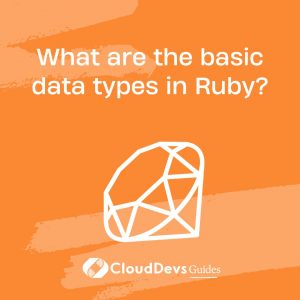Ruby Q & A
What are the basic data types in Ruby?
In Ruby, like many other programming languages, data types are fundamental building blocks used to represent and manipulate different kinds of information within a program. Ruby is dynamically typed, meaning you don’t need to explicitly declare the data type of a variable; it’s determined at runtime based on the value assigned to it. Here are some of the basic data types in Ruby:
- Integer: Integers in Ruby represent whole numbers. They can be positive, negative, or zero. Ruby provides built-in support for arbitrary-precision integers, allowing you to work with very large numbers without worrying about overflow.
- Float: Floats are used to represent real numbers with decimal points. They are suitable for tasks involving measurements, scientific calculations, or any situation where fractional values are needed.
- String: Strings are sequences of characters, enclosed in either single (”) or double (“”) quotes. Ruby provides a rich set of string manipulation methods, making it easy to work with text data.
- Boolean: Boolean data types have only two possible values: `true` and `false`. They are often used for logical comparisons and conditional statements.
- Array: An array is an ordered collection of values. Ruby arrays can contain elements of different data types, and they are indexed starting from 0. You can add, remove, and manipulate elements in arrays easily.
- Hash: A hash is a data structure that stores key-value pairs. Keys are unique, and you can quickly look up values by their associated keys. Hashes are often used for mapping relationships between data.
- Symbol: Symbols are lightweight and immutable identifiers represented by a colon followed by a name (e.g., `:symbol_name`). They are commonly used as keys in hashes and for efficient string comparisons.
- Nil: `nil` represents the absence of a value or the absence of data. It’s often used to initialize variables or indicate that a value doesn’t exist.
- Range: A range represents an interval of values. It can be created using the `..` or `…` operators and is commonly used for iteration and conditional checks.
These basic data types serve as the foundation for more complex data structures and objects in Ruby. Understanding how to work with them is essential for effective programming in the language. Ruby’s dynamic and flexible nature allows you to use these data types in various ways to build powerful and expressive programs.

Previously at


Chile

GMT-3
Experienced software professional with a strong focus on Ruby. Over 10 years in software development, including B2B SaaS platforms and geolocation-based apps.



